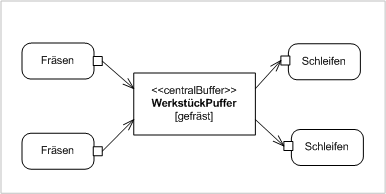Buffer node (UML)
A buffer node ( CentralBufferNode ) is a model element in the Unified Modeling Language (UML), a modeling language for software and other systems.
Buffer nodes are special object nodes in UML2 activities . The buffer node is closely related to the pin , another object node. Both the pin and the buffer node can temporarily store a certain number of objects according to their capacity, that is, both have the option of buffering objects in the flow through an activity.
In contrast to a pin, however, a buffer node does not necessarily have to belong to an action . The buffer node can be inserted anywhere in the activity as a buffer. It is connected to surrounding object nodes via incoming and outgoing object flows.
notation
To distinguish a buffer node from another object node in an activity, it has the stereotype «centralBuffer».
The figure on the left shows a buffer node that receives objects from two actions via two object flows. It is connected to two further actions via two outgoing object flows. This activity models the fact that two actions simultaneously mill workpieces and store them in an intermediate storage area, from which two further actions are used for the subsequent work step.
Differences to UML 1.x
The buffer node was newly introduced in UML2.
